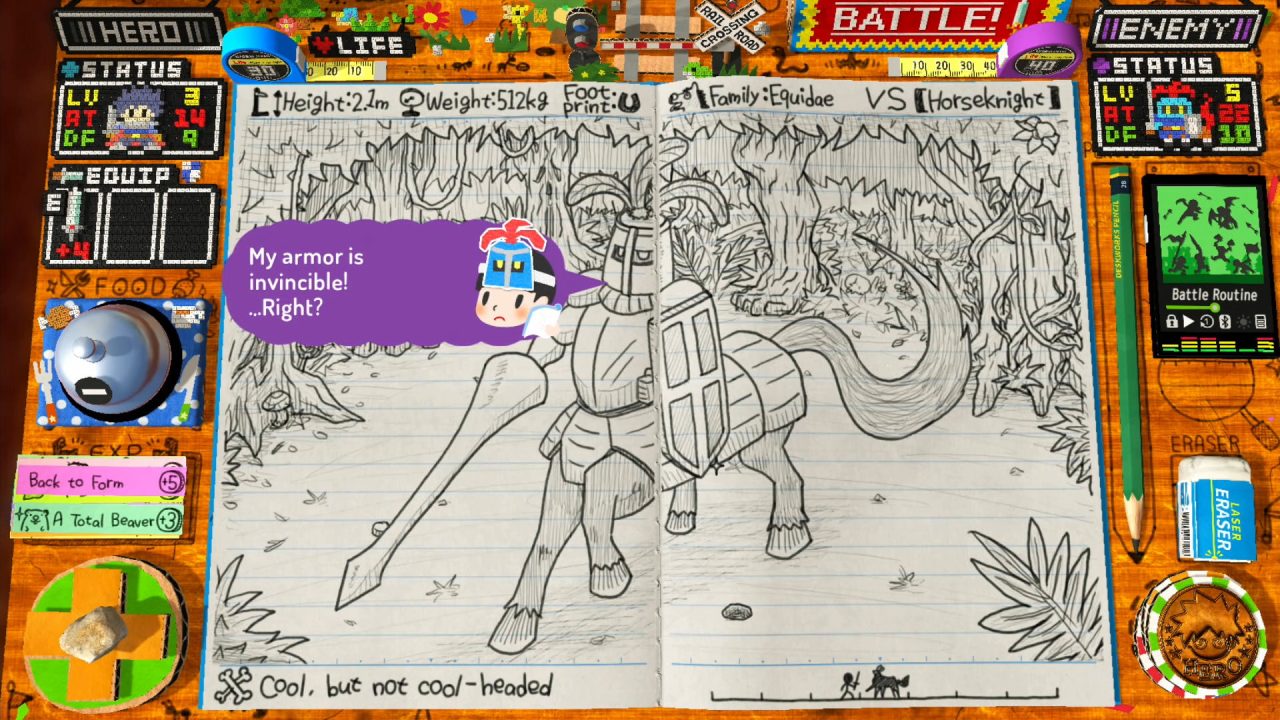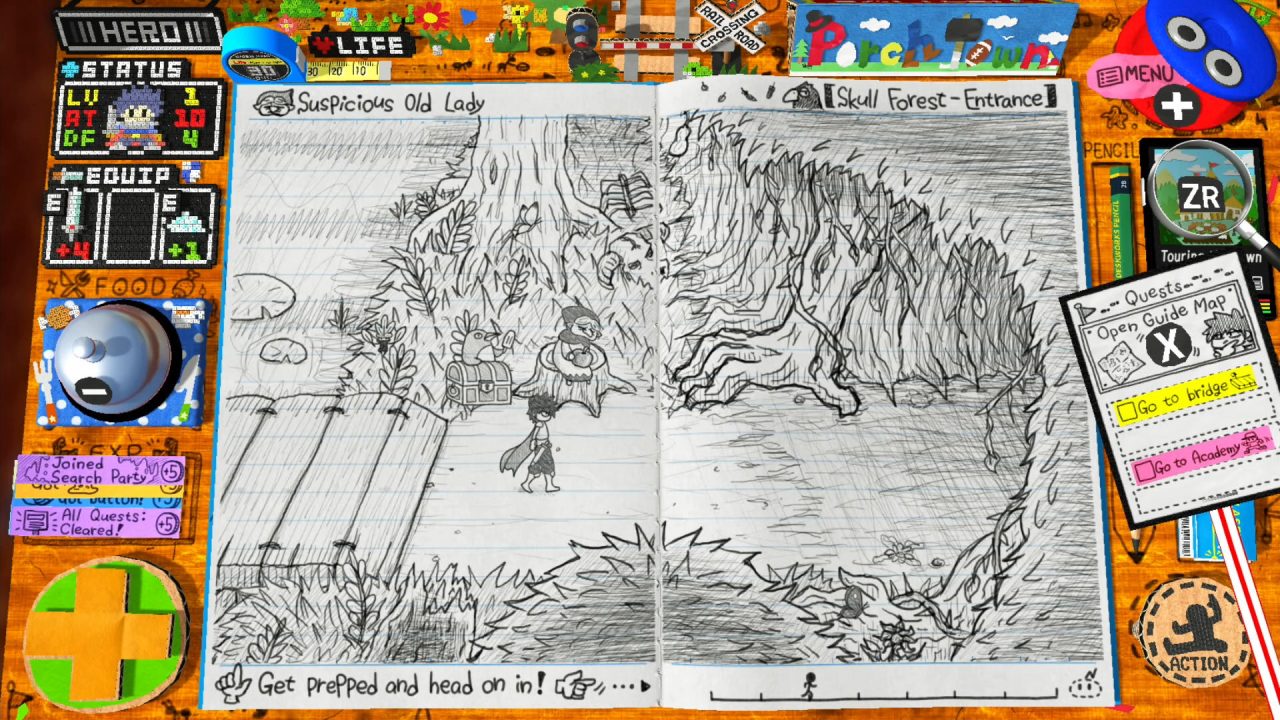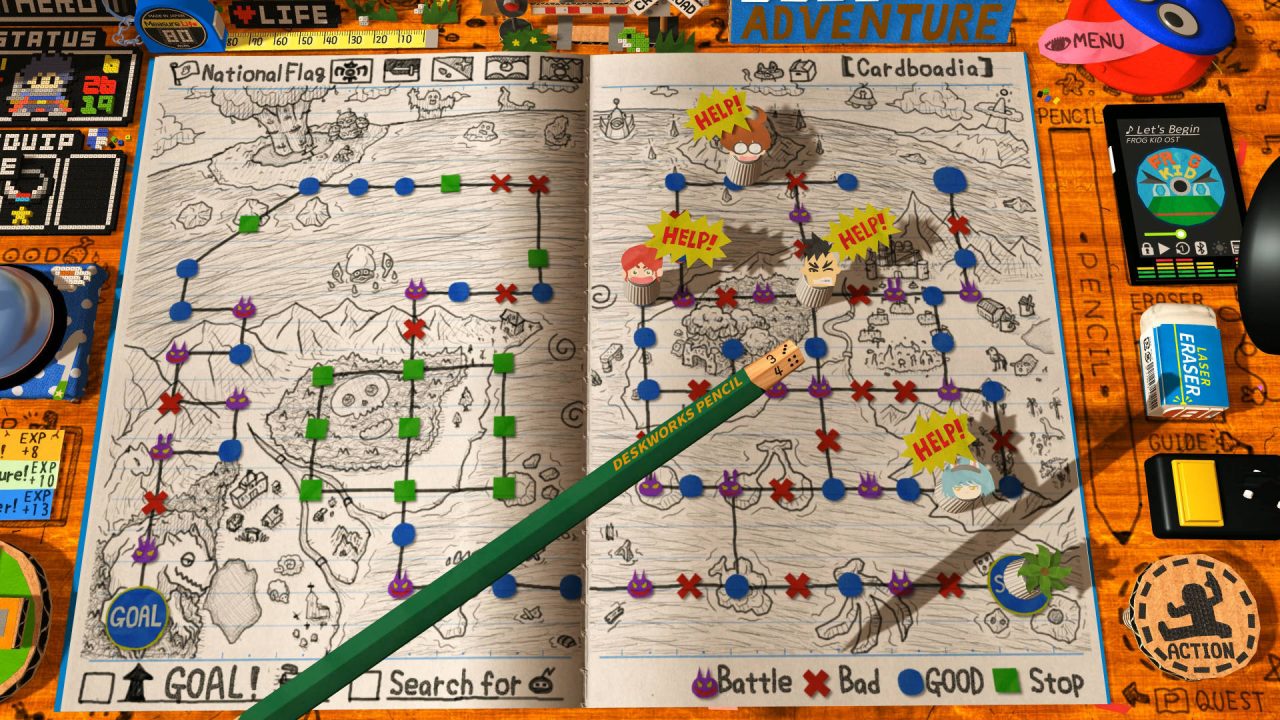When I think of my childhood school days, I recall sitting in class wishing I was finding the next star in Super Mario RPG or searching for Sephiroth in Final Fantasy VII. I’m sure those of us who regularly follow RPGFan had similar daydreams during class, perhaps even dreaming designs for our own RPGs. In RPG Time: The Legend of Wright, one kid is immediately pursuing that dream, having built his own RPG experience from scratch. And right now, you’re at this schoolchild’s desk — and mercy — as you indulge in his made-up fantasy.
Young Kenta has laid out the entire scene for you: a status screen made of beads, background music from his phone, and a tape measure to keep track of your hit points. It’s RPG time! Kenta’s drawn up an adventure in his notebook where you play as the Hero Wright: a soft-spoken, spiky-haired lad with an insatiable appetite. The Land of Light is being ravaged by Dethgawd, an evil demon who kidnapped Lay (the Princess of Light) and usurped her castle. Despite Wright’s best efforts, the massive Dethgawd effortlessly smacks our hero into the faraway land of Cardboardia. Wright must acquire strength and some helpful friends during his long journey through Cardboardia and back to the castle. Though the premise is simple, it’s aided by some inventiveness from Kenta’s frugal but clever spirit. The boy sees household items as essential ingredients for an adventure. For example, a cut-out paper hilt attaches to a pencil to form Wright’s sword.

The silly and random situations you find yourself in are a tribute to the wild, playful, creative energy that comes from the mind of a child. One moment, you’re climbing a ladder made of stuffed animals. The next, you’re playing baseball against a tank known as BaseballMan with an angry baseball for a face. Kenta immerses you in his world using practical effects, like raining confetti when you’ve succeeded at a quest or awarding you experience points via little strips of paper with achievements written on them. The best moments occur when the real world encroaches on the game in Kenta’s notebook. For example, a brewing storm fortuitously sets the mood when you reach the creepy witch’s mansion.
Despite the game’s title and some obscure references to classic RPGs, RPG Time’s gameplay is, ironically, too eclectic to be considered an RPG. The adventure, tightly guided by Kenta, often breaks out into little minigames. Overall, it probably lands closest to a point-and-click adventure or an older interactive full-motion video game, like the ancient arcade classic Dragon’s Lair, or even that ‘90s Simon Says-like toy, Bop It.
Of course, as Kenta says, “No RPG would be complete without battles!” The closest thing RPG Time has to a “standard” battle is something like a first-person, turn-based boss fight. On your turn, you move the cursor with the left stick. Once it’s in the striking position, you make a slashing motion with the right stick. That is your turn, and it all feels surprisingly satisfying. Then the enemy takes its turn. It’s more of a light, interactive puzzle than a fight, really. The only pressure on you is that you need to solve it before the enemy beats you down to zero health. The key lies in using your noggin to figure out where a monster’s weak spot might be, though Kenta eagerly offers plentiful hints. Other times, combat is action-oriented, where you simply hack away at monsters. While these segments can be fun and feel dynamic, there’s no real meat or core gameplay for a seasoned RPG gamer to dig into. But RPG Time is much more about the experience of enjoying the little adventure your buddy has devised than, say, managing a party.

RPG Time encourages playfulness more than quest completion. Solutions to the game’s light “puzzles” are usually obvious, but it’s often more fun to see what happens when you make the wrong choice, even with the likelihood of a game over screen. For example, during one segment, when Wright attends adventuring school, the teacher poses a question, and you choose whether or not to raise your hand. If you don’t, one of the other students might respond, or the teacher might give up and tell you off. Of course, you can also answer the question incorrectly if you’d like to. Eventually, you can access a doodle pad which lets you doodle whenever you feel like it. It’s a reminder that messing around can help spur creativity.
On the other hand, RPG Time feels a little odd considering its name and aesthetic. An adult may enjoy the references and creativity employed by the designers, but its over-simplicity falls short of an RPG-like experience. While a kid might enjoy the game for the sheer ingenuity of it all, it wouldn’t serve as an introduction to the genre as much as, say, a Dragon Quest game might. Though RPG Time references plenty of RPG tropes, it doesn’t do much to replicate even the basic feel or flow of playing an actual RPG. Instead, it’s little more than a fun, short diversion for RPG fans to reminisce on games of yore.
RPG Time is all about its visuals, which mostly depict everyday objects you might find around school and convey the joyous creativity of a kid working with what he has available. Since most of the game takes place on the notebook’s pages, the impressive graphite pencil drawings really come to life. Outside of the notebook, the school supplies move around in a lively fashion, with paper puppets attached to straws and erasers swooping in to hastily revise what’s on the pages.

The music in Kenta’s playlist feels exactly like something you would have heard while playing a Dragon Quest or a Legend of Zelda game, with a mix of pixelated and high-fidelity tunes. There’s no voice acting, but you could imagine a kid excitedly leading you through his story through the energetic writing. The sound effects go a long way toward making your actions feel satisfying, like the sound of iron cutting through the air as you swing your sword at an enemy. The controls are sharp and help facilitate an enjoyable journey through Cardboardia. All the same, I couldn’t help but think RPG Time would be more fun on a touch screen or with now-abandoned motion controls, like on the Wii.
RPG Time respects your time, allowing you to save the world in roughly 7 hours. The tale was expeditiously wrapped up before Kenta or I ran out of steam or energy. It’s a fun re-creation of the boundless zeal and creativity a child would bring to one of his creations, and it’s an adorable love letter to all kinds of games. The game’s invitation to play pushes it beyond simply a game to conquer. That’s a positive because though it can be fun and engaging, it lacks the crunchy investment that RPGs typically require. Still, the overflowing creativity makes your journey in RPG Time worthwhile for letting your inner child run wild.


